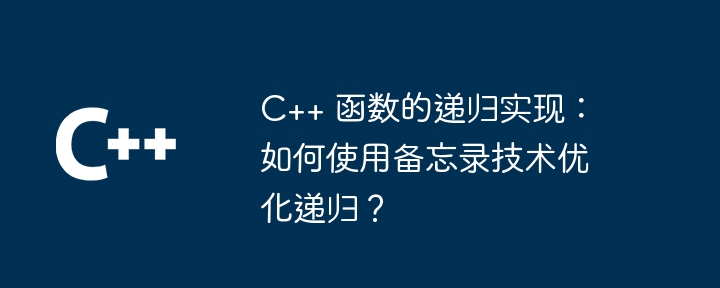
Optimize recursive memo technology: use memos to store calculated results to avoid repeated calculations. Use unordered_map in C as a reminder to check if the result exists before calculating it. Store the calculation results and return them to improve the performance of computationally intensive tasks such as traversing directories.

Recursive implementation of C functions: Optimization using memoization technique
Recursion is a powerful technique that allows a function to call itself. However, when a recursive function solves the same problem, it may cause a lot of repeated calculations, thus reducing runtime performance. The memoization technique is a common technique for optimizing recursive algorithms and can significantly improve efficiency.
What is memo technology?
The memo technique involves creating and maintaining a table called a memo. This table stores the results of function calls that have been calculated. When an identical function call occurs again, we first check the memo to see if it has already been evaluated. If it has already been calculated, we directly return the stored result to avoid double calculation.
Implementation
Implementing memo optimization in C is very simple. Here is an example function that uses memo to calculate Fibonacci numbers:
#include <unordered_map>
using namespace std;
// 创建备忘录
unordered_map<int, int> memo;
int fibonacci(int n) {
// 检查备忘录中是否存在结果
if (memo.find(n) != memo.end()) {
return memo[n]; // 返回存储的结果
}
// 计算结果并存储在备忘录中
int result;
if (n <= 1) {
result = 1;
} else {
result = fibonacci(n - 1) + fibonacci(n - 2);
}
memo[n] = result;
return result;
} In the above code, memo an unordered map is used as a memo. fibonacci The function first checks whether the result of the specified number n exists in memo. If present, the function returns the stored result directly. Otherwise, it computes the result, stores it in the memo, and returns it.
Practical Case
Let’s consider a real-world example: counting the number of files in a directory. We can use a recursive algorithm, which traverses the directory and processes all subdirectories recursively. Without the use of memos, the algorithm would encounter severe double counting when traversing large directory structures.
Using memos, we can significantly improve performance. When a directory is accessed, we can store its path in a memento and junto con its file count. When the same directory is accessed later, we can retrieve the count directly from the memo, avoiding double counting.
Conclusion
The memo technique is an effective way to optimize recursive functions in C. By storing already calculated results, we can avoid repeated calculations, thus improving runtime performance. Memo optimization is particularly beneficial when solving algorithms that contain a large number of repeated subproblems.
The above is the detailed content of Recursive implementation of C++ functions: How to optimize recursion using memoization technique?. For more information, please follow other related articles on the PHP Chinese website!
 What are the differences between c++ and c language
What are the differences between c++ and c language
 Recommended learning order for c++ and python
Recommended learning order for c++ and python
 Cost-effectiveness analysis of learning python and c++
Cost-effectiveness analysis of learning python and c++
 Is c language the same as c++?
Is c language the same as c++?
 Which is better to learn first, c language or c++?
Which is better to learn first, c language or c++?
 The difference and connection between c language and c++
The difference and connection between c language and c++
 C++ software Chinese change tutorial
C++ software Chinese change tutorial
 Cost-effectiveness analysis of learning python, java and c++
Cost-effectiveness analysis of learning python, java and c++




